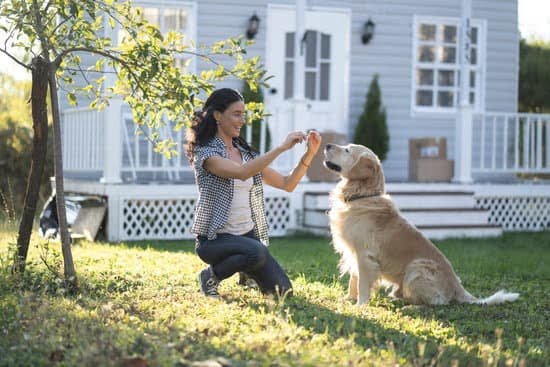Dog training is essential for a harmonious relationship between pets and their owners. Knowing what methods to train a dog is crucial in ensuring their well-being and obedience. Proper training not only helps prevent behavioral issues but also strengthens the bond between you and your furry companion.
Positive reinforcement, such as using treats and praise, can be effective in encouraging good behavior in dogs. Clicker training is another popular method that involves using a clicker to signal to your dog that they have performed a desired action correctly. These techniques focus on rewarding the dog for desirable behavior rather than punishing them for mistakes.
In addition to basic commands like sit, stay, and come, crate training can be beneficial for housebreaking and providing a sense of security for your dog. Leash training is also important for teaching dogs to walk politely without pulling. By addressing specific behavioral issues and practicing consistency in training, owners can establish a strong foundation for their dog’s obedience and overall well-being.
Positive Reinforcement
Using treats as a form of positive reinforcement can be especially helpful during the training process. It is important to choose treats that are both enticing to your dog and easy to consume quickly so that the training session flows smoothly. Additionally, verbal praise and physical affection are also essential components of positive reinforcement training. Dogs thrive on their owner’s approval and attention, making these gestures powerful motivators for learning.
One key aspect of positive reinforcement training is timing. It is crucial to reward your dog immediately after they display the desired behavior so they can make a clear connection between their actions and the reward. Consistency in using positive reinforcement will help your dog understand what behaviors are expected of them, leading to faster and more successful training outcomes.
| Important Aspect | Description |
|---|---|
| Treat Selection | Choose treats that are enticing and easy to consume |
| Timing | Reward immediately after desired behavior for effective results |
| Consistency | Using positive reinforcement consistently helps dogs understand expected behaviors |
Clicker Training
One of the main advantages of clicker training is its precision and timing. The clicker allows you to mark the exact moment your dog performs the desired behavior, helping them make positive associations with that specific action. This can be especially useful when teaching more complex commands or shaping behaviors in stages. With consistent use of the clicker, dogs can often learn commands faster and retain them better.
To effectively use a clicker for training commands, start by associating the sound of the clicker with rewards through a process called “charging the clicker.” Simply click the device and immediately give your dog a treat multiple times in quick succession. This will help your dog understand that the click sound signals something good is coming their way.
Once your dog is familiar with this association, you can begin using the clicker to mark and reward desired behaviors during training sessions. Remember to keep training sessions short, positive, and rewarding for best results.
| Advantages of Clicker Training | How to Use a Clicker Effectively |
|---|---|
| Precision in marking desired behavior | Associate click sound with rewards through “charging” |
| Faster learning and better retention of commands | Mark exact moment of desired behavior for clarity |
Crate Training
One of the main advantages of crate training is that it helps with housebreaking. Dogs naturally do not like to eliminate in their sleeping area, so by keeping them in a crate when you cannot supervise them, you are teaching them how to control their bladder and bowels. This can significantly speed up the housebreaking process as it establishes a routine and helps the dog learn where they should and should not relieve themselves.
In addition to housebreaking, crates also provide a sense of security for dogs. Dogs are den animals by nature, so having a designated space that is theirs can help reduce anxiety and provide a safe retreat when they need some alone time. By making the crate comfortable with soft bedding and toys, you can create a positive association with the crate, making it a place your dog actually enjoys being in.
Remember that patience and consistency are key when implementing crate training. It’s important to never use the crate as punishment and always make it a positive experience for your pup.
Behavioral Training
Behavioral issues such as barking or jumping can be common challenges that dog owners face when training their furry companions. Understanding the root cause of these behaviors is crucial in effectively addressing and modifying them. In this section, we will discuss some effective methods to help train your dog to overcome behaviors such as excessive barking or jumping on people.
Identifying the Cause
Before implementing any training techniques, it is important to first identify the underlying cause of the behavior. Dogs may bark excessively due to boredom, anxiety, fear, or even a need for attention. Similarly, jumping can be a result of excitement or seeking affection. By understanding why your dog exhibits these behaviors, you can tailor your training approach accordingly.
Positive Reinforcement
One of the most effective methods to address behavioral issues in dogs is through positive reinforcement. This involves rewarding desired behaviors with treats, praise, or toys. For example, if your dog barks excessively when someone knocks on the door, you can train them to remain calm by rewarding them when they stay quiet during these situations. Similarly, teaching your dog an alternative behavior such as sitting instead of jumping on guests can also be reinforced through positive rewards.
Consistency and Patience
Consistency is key when addressing behavioral issues in dogs. It is important to set clear boundaries and expectations for your furry friend and consistently reinforce these rules. Patience is also vital during the training process as changing behavior takes time and dedication. By being patient and consistent with your training efforts, you can help your dog overcome behavioral issues and build a strong bond based on trust and respect.
By implementing these methods and techniques into your training routine, you can effectively address specific behavioral issues such as barking or jumping in your dog. Remember that every dog is unique, so it may take some trial and error to find what works best for your furry friend. With patience, consistency, and positive reinforcement, you can help your dog develop good behavior habits and strengthen your relationship with them.
Obedience Training
Sit
One of the first commands you should teach your dog is “sit.” This command is not only useful for polite greetings but also serves as a building block for other commands. To teach your dog to sit, hold a treat close to their nose and slowly move it up and over their head.
As they follow the treat with their nose, their bottom will naturally lower into a sitting position. Once they are sitting, say the command “sit” and reward them with the treat.
Stay
The “stay” command is crucial for your dog’s safety in various situations. To teach your dog to stay, start by asking them to sit. Then take a step back while holding your palm out towards them and say “stay.” If they remain in place, return to them and reward them with praise or a treat. Gradually increase the distance and duration of the stay as your dog becomes more comfortable with the command.
Come
The “come” command is essential for calling your dog back to you in any situation. To teach this command, start by getting down on their level and using an excited tone of voice while saying “come.” You can also use treats or toys as motivation for them to come towards you. When they reach you, be sure to reward them generously. Practice this command in different environments and gradually increase distractions to solidify their response.
By consistently practicing these basic obedience commands with positive reinforcement, you can help your canine companion become a well-behaved member of your family. Remember that patience, consistency, and love are key components of successful obedience training. Keep in mind that every dog is unique, so feel free to modify these methods according to your pet’s individual needs and personality traits.
Consistency
Consistency in training means setting clear rules and boundaries for your dog and enforcing them consistently. This includes using the same commands for the same behaviors every time, rewarding good behavior consistently with treats or praise, and providing correction for undesirable behavior promptly and consistently. By doing so, you are communicating clearly to your dog what is acceptable and what is not, helping them learn quickly and effectively.
In addition to helping your dog learn faster, consistency in training also helps strengthen the bond between you and your furry companion. When your dog knows what to expect from you and feels secure in following your guidance, they will trust you more readily and develop a deeper connection with you.
Consistent training also helps build mutual respect between you and your dog, leading to a harmonious relationship based on clear communication and understanding. So remember, no matter what methods you choose to train your dog, consistency is key to success both in training outcomes as well as in building a strong bond with your canine companion.
Advanced Training Techniques
Once your dog has mastered basic commands and behaviors, you may want to consider exploring more advanced training techniques to further enhance their skills and behavior. One popular method is known as agility training, where dogs navigate through obstacle courses with the guidance of their owners. This type of training not only provides physical exercise but also mental stimulation for your furry friend.
Another advanced training technique to consider is scent detection training. Many dogs have a keen sense of smell and excel at sniffing out specific scents. By incorporating scent detection training into your dog’s routine, you can engage their natural instincts and provide a fun yet challenging activity for them to participate in. This can be particularly useful for working dogs or breeds known for their superb olfactory capabilities.
Furthermore, some pet owners may choose to explore trick training as an advanced method to keep their dogs mentally sharp and engaged. Teaching your dog tricks such as rolling over, playing dead, or even fetching specific items by name can be a rewarding experience for both you and your canine companion.
It not only strengthens the bond between you but also provides entertainment and enrichment for your pet. These advanced training techniques go beyond the basics and offer a way to continue developing your dog’s skills while keeping them mentally stimulated and engaged.
Conclusion
Training a dog is not just about teaching them obedience; it’s about fostering a strong bond between you and your furry companion. It is crucial to understand the importance of proper training to ensure a harmonious relationship with your pet. By investing time, patience, and consistency in training, you are not only shaping their behavior but also creating a fulfilling partnership built on trust and understanding.
When considering what methods to train a dog, it’s essential to explore various techniques that cater to their individual needs and learning styles. Positive reinforcement, clicker training, crate training, leash training, behavioral training, obedience training – these are just some of the methods available to help mold your dog into a well-rounded and well-behaved family member. Each approach offers unique benefits and can be combined to create a comprehensive training program tailored to your pet’s specific requirements.
Ultimately, the key to successful training lies in consistency. By practicing patience and maintaining a consistent routine, you can effectively communicate with your dog and guide them towards desired behavior. Whether you are working on basic commands or advanced tricks, staying consistent in your approach will yield the best results. Remember that every dog is unique, so be prepared to adapt your methods as needed to ensure a positive learning experience for both you and your furry friend.
Frequently Asked Questions
What Is the Best Method to Train a Dog?
The best method to train a dog is positive reinforcement. This involves rewarding good behavior with treats, praise, or playtime. It’s effective because it encourages dogs to repeat behaviors that result in positive outcomes.
What Are the 7 Basics of Dog Training?
The 7 basics of dog training include socialization, obedience training, crate training, housebreaking, leash training, basic commands like sit and stay, and addressing behavioral issues like barking or jumping. Consistency and patience are key in successfully training a dog.
Are There Three Main Ways to Train a Dog?
There are three main ways to train a dog: positive reinforcement, negative reinforcement, and punishment-based techniques. Positive reinforcement focuses on rewarding desired behaviors while negative reinforcement involves removing an unpleasant stimulus when the dog performs the correct action. Punishment-based techniques should be avoided as they can lead to fear and aggression in dogs.

Welcome to the blog! I am a professional dog trainer and have been working with dogs for many years. In this blog, I will be discussing various topics related to dog training, including tips, tricks, and advice. I hope you find this information helpful and informative. Thanks for reading!





